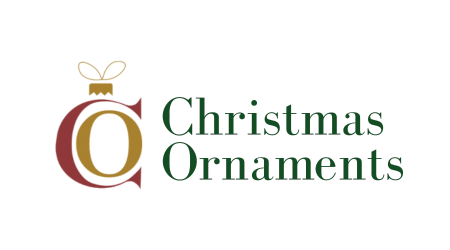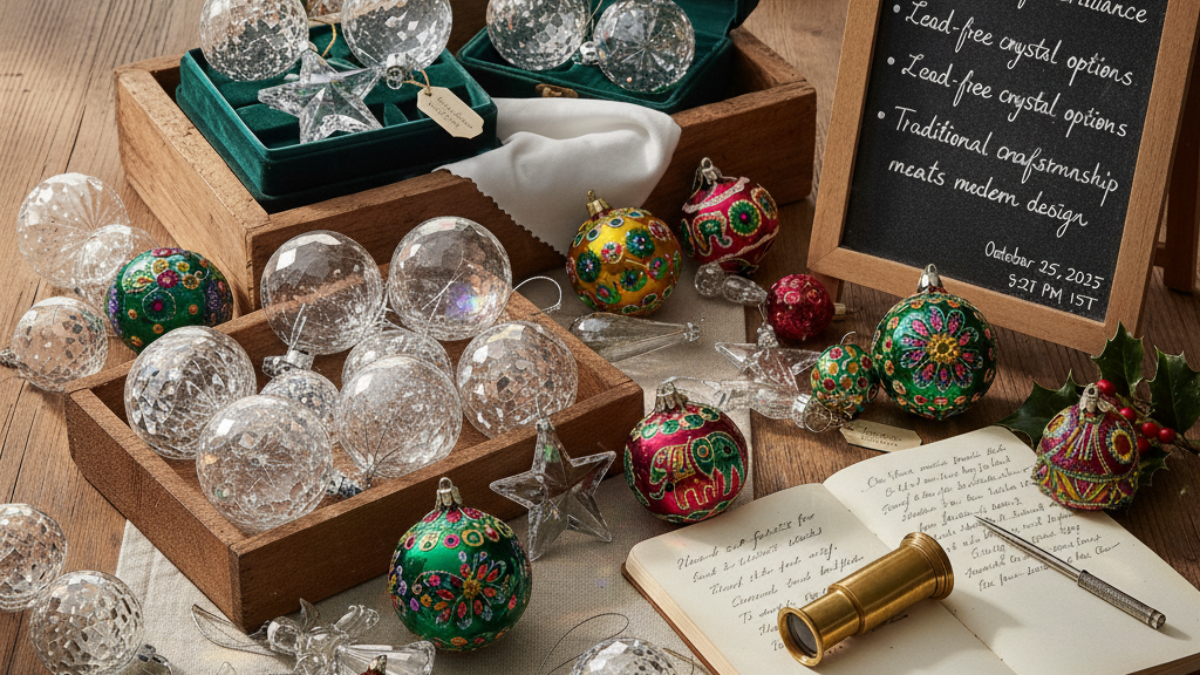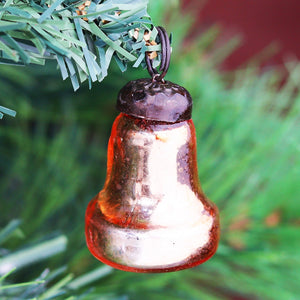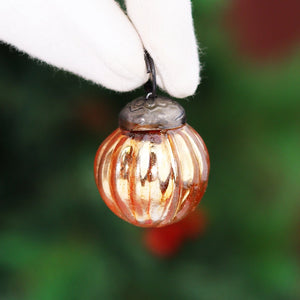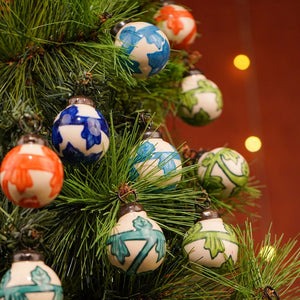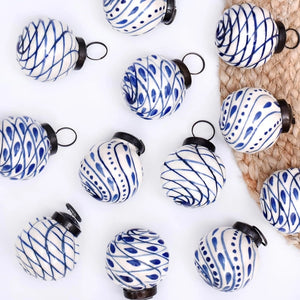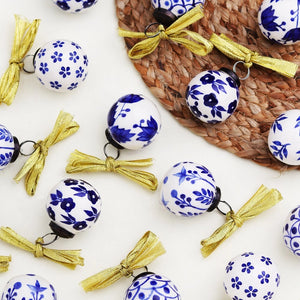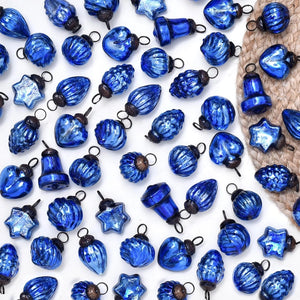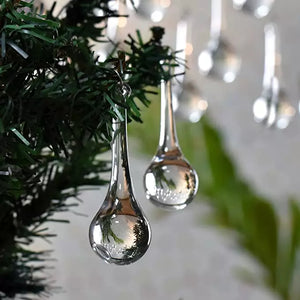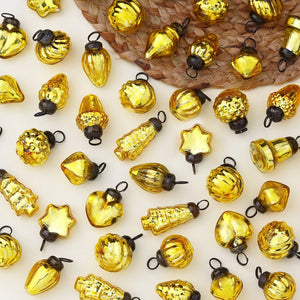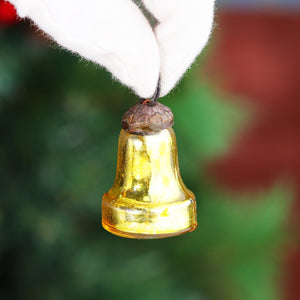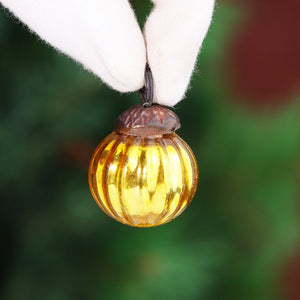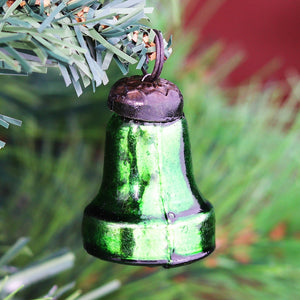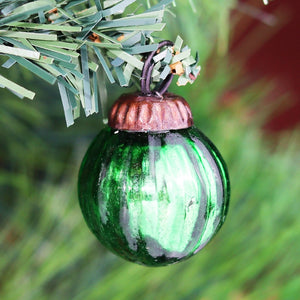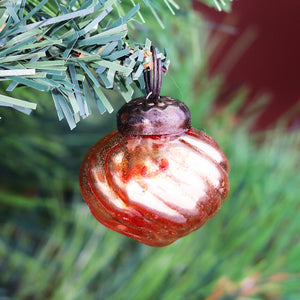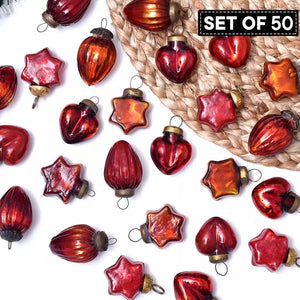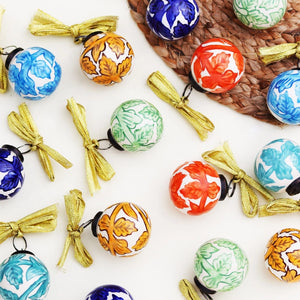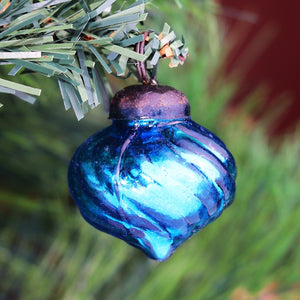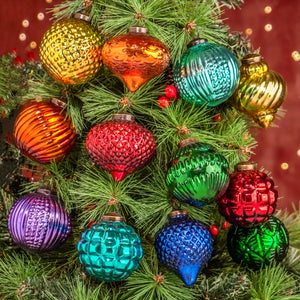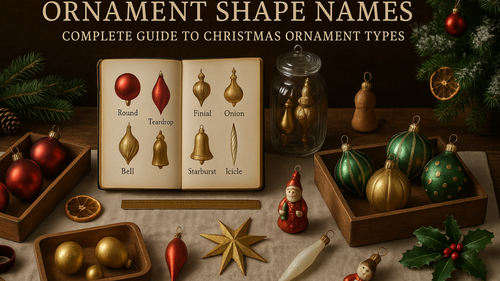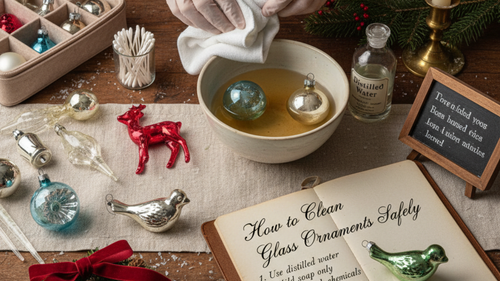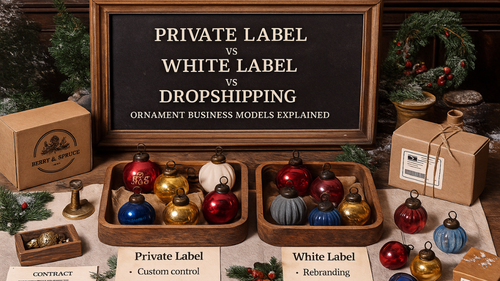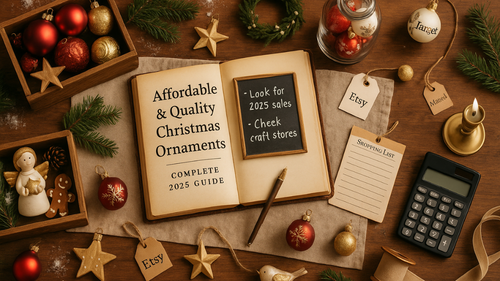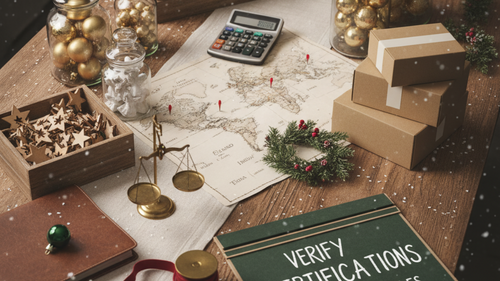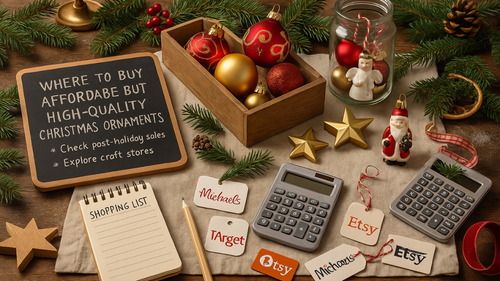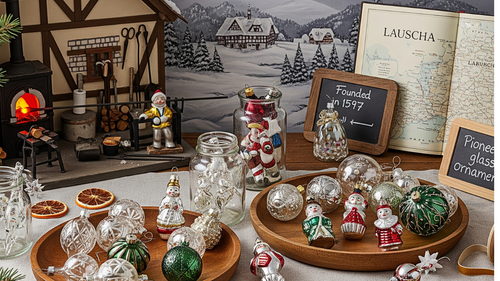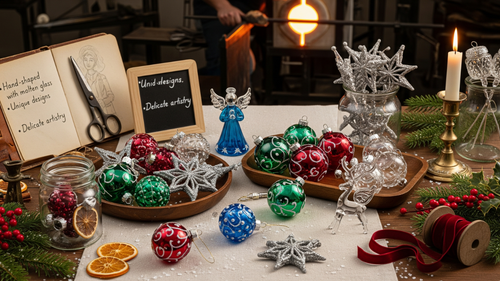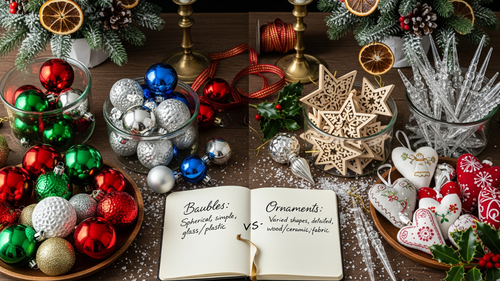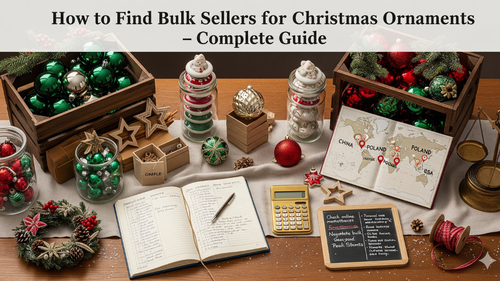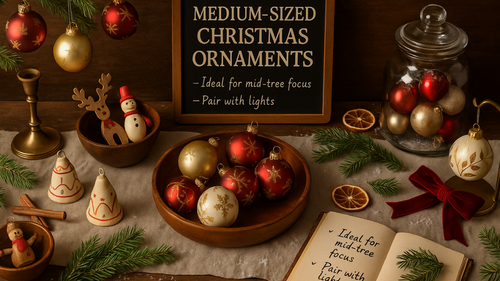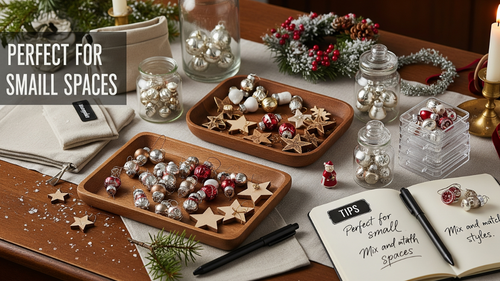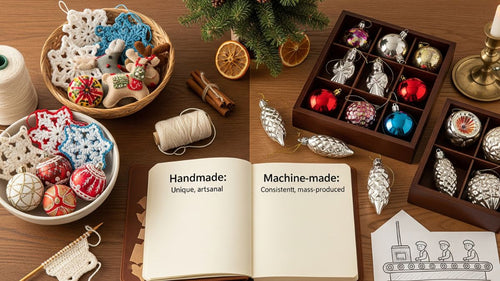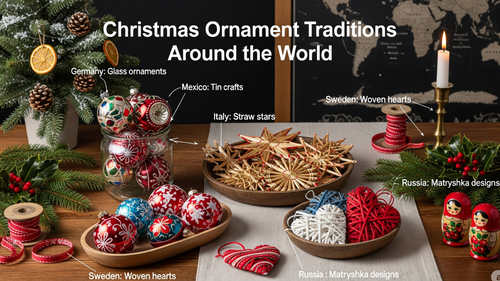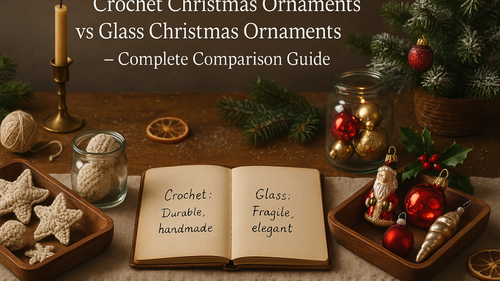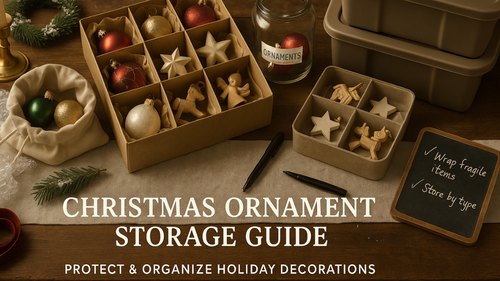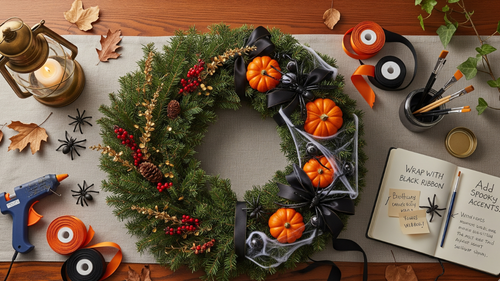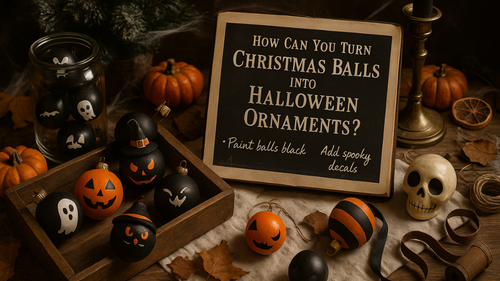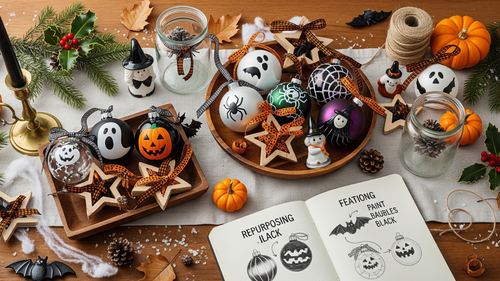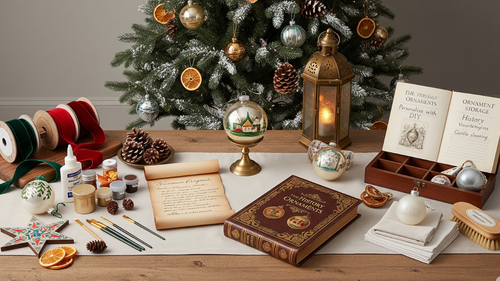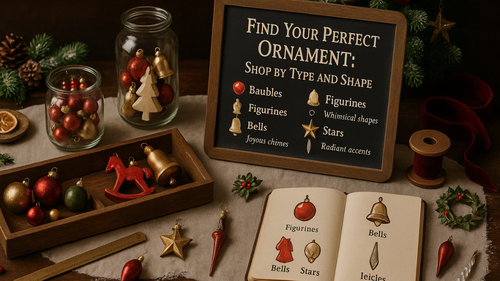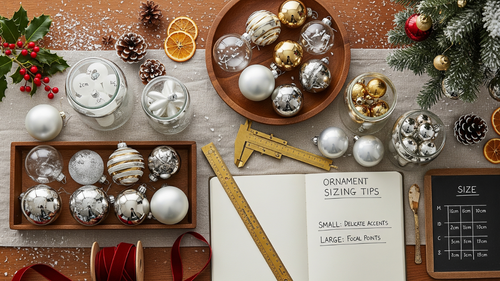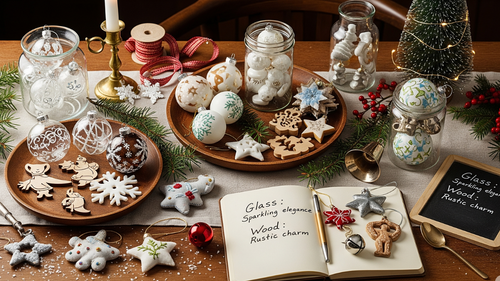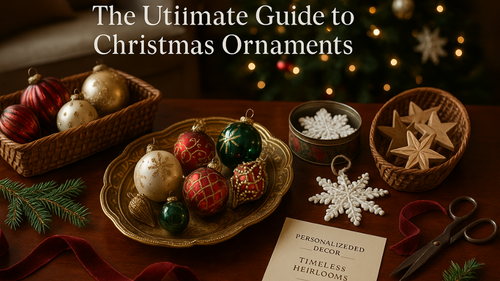When light catches a crystal ornament hanging from your tree, something magical happens. That prismatic sparkle transforms an ordinary holiday display into something extraordinary. Crystal and cut-glass ornaments have captivated decorators for over 175 years, representing not just decoration but heritage, artistry, and the timeless pursuit of beauty.
Whether you're a seasoned collector searching for authentic Lauscha ornaments, a homeowner wondering why crystal costs more than standard glass, or a business buyer seeking bulk wholesale options, this comprehensive guide reveals everything you need to know about crystal and cut-glass Christmas ornaments in 2025.
From the scientific reasons behind their brilliance to affordable eco-crystal alternatives, from Victorian heritage to modern LED-reactive designs, this resource answers every question about selecting, decorating with, maintaining, and sourcing these luminous treasures. You'll discover why handmade pieces command premium prices, how to identify authentic crystal, and where global manufacturing has made luxury accessible to everyone.
Key Takeaways
- Crystal vs. Glass: Crystal contains lead oxide or minerals that increase refraction, creating superior sparkle compared to standard glass
- Price Range: Modern manufacturing offers crystal-look ornaments from $0.25 to premium handcut pieces at $50+ per ornament
- Care Essentials: Use distilled water and microfiber cloths; never use ammonia on crystal or submerge painted ornaments
- Authentic Identification: Real crystal has distinct weight, clarity, and produces a clear ring when gently tapped
- Sustainability: Lead-free eco-crystal and recycled glass production dominate 2024-2025 manufacturing standards
- Global Sources: Major production centers include the Czech Republic, Poland, India, and Germany, each with distinct styles
What Makes Crystal & Cut-Glass Ornaments Special?
The Science of Sparkle: Why Crystal Outshines Regular Glass
The extraordinary brilliance of crystal ornaments comes from physics, not magic. Crystal contains lead oxide (traditional formula) or barium, zinc, or potassium (lead-free modern versions) that increases the refractive index. When light enters crystal, it bends at sharper angles than in regular glass, splitting into spectral colors like a prism.
Standard glass ornaments have a refractive index of around 1.5, while crystal ranges from 1.6 to 1.7. This seemingly small difference creates dramatically more sparkle and rainbow effects. The addition of hand-cut facets multiplies these light interactions, transforming each ornament into a miniature light sculpture.
Crystal vs. Glass vs. Cut Glass: Material Comparison
| Feature | Standard Glass | Cut Glass | Crystal |
|---|---|---|---|
| Composition | Silica, soda, lime | Same as glass, precision cut | Silica + lead oxide or minerals |
| Refraction | Low (1.5) | Low to medium | High (1.6-1.7) |
| Sparkle | Basic | Enhanced by facets | Maximum prismatic effect |
| Weight | Light | Light to medium | Noticeably heavier |
| Durability | Moderate | Moderate | More brittle but chip-resistant |
| Cost Range | $0.25-$5 | $3-$20 | $8-$100+ |
Why Handcut Facets Matter
Machine-molded ornaments can achieve clarity and color, but hand-cut facets create depth and complexity that mass production cannot replicate. Each angled surface acts as a miniature mirror and prism simultaneously. Skilled artisans cut anywhere from 12 to over 100 facets on a single ornament, with each cut positioned to maximize light interaction.
Featured Products
This is why handmade ornaments command premium prices. The human eye and hand achieve variations and precision that automated cutting cannot match, especially in complex geometric patterns like stars, snowflakes, and diamond cuts.
The History & Evolution of Glass Ornaments
Lauscha 1847: Where It All Began
The story of glass Christmas ornaments begins in Lauscha, Germany, where glassblower Hans Greiner created the first commercially produced glass ornament in 1847. Before this innovation, families decorated trees with apples, nuts, and handmade paper creations. Greiner's silvered glass balls offered something revolutionary: affordable beauty that caught candlelight with a mesmerizing effect.
By the 1880s, Lauscha exported millions of ornaments worldwide. The town's cottage industry employed entire families, with parents blowing glass while children painted designs and applied decorations. This artisan tradition continues today, with seventh-generation glassblowers still producing ornaments using nineteenth-century techniques.
Featured Products
Bohemian Crystal Meets Christmas Tradition
The Czech region of Bohemia had produced fine crystal since the 1600s, renowned for its clarity and cutting techniques. When Bohemian artisans applied crystal craftsmanship to Christmas ornaments in the late 1800s, they created a new category of luxury holiday décor. These faceted crystal pieces featured complex geometric patterns that transformed candlelight into dancing rainbows.
Czech and Polish crystal ornaments became symbols of refined taste across Victorian Europe and America. Wealthy families displayed entire trees adorned exclusively with cut crystal, while the emerging middle class purchased one or two pieces annually as treasured additions to their collections.
Victorian Symbolism and the Language of Light
Victorian culture imbued Christmas ornaments with deep symbolism. Clear crystal represented purity and divine light, while colored glass symbolized different virtues. Red signified love and sacrifice, blue represented heaven and truth, green meant eternal life, and gold embodied divine glory. Families selected ornaments not just for beauty but for the spiritual messages they conveyed.
Featured Products
World War II Disruption and the Shiny Brite Revolution
World War II halted European ornament production and exports. American entrepreneur Max Eckardt filled this void by founding Shiny Brite in 1937, creating affordable silvered glass ornaments using automated machinery. These became the iconic ornaments of the 1940s-1960s, featuring simple shapes in vibrant colors with striped, flocked, or glittered finishes.
While lacking the complexity of European crystal, Shiny Brite democratized ornament ownership. Millions of American families could afford full sets, creating the standardized Christmas aesthetic that dominated mid-century America.
The 2020s Revival: Sustainability Meets Heritage
Current trends reflect growing environmental awareness and appreciation for traditional craftsmanship. Between 2023 and 2025, manufacturers across Czech Republic, Poland, and India have invested heavily in lead-free crystal formulations and energy-efficient kilns. Recycled glass production has increased 340% since 2020, according to European Glass Alliance data.
Simultaneously, artisan workshops have experienced renewed demand. Consumers increasingly value the story behind their ornaments, willing to pay premium prices for pieces connecting them to centuries-old traditions while supporting sustainable production methods.
How Are Crystal Ornaments Made?
From Silica to Sparkle: The Manufacturing Process
Creating crystal ornaments involves precise chemical ratios and controlled heat. Manufacturers combine silica sand (the glass base), soda ash (to lower melting point), limestone (for durability), and either lead oxide or lead-free minerals (for crystal properties). This mixture melts at 1400-1500°C (2550-2730°F) in specialized furnaces.
For blown ornaments, glassblowers gather molten material on hollow pipes, inflating spheres or shapes through skilled breath control and rotation. The process requires years to master, as temperature, thickness, and timing must balance perfectly. A too-thick ornament weighs down branches, while too-thin glass shatters easily.
Machine-molded ornaments press molten glass into precision molds, allowing mass production at consistent quality. Modern manufacturers like those featured on ChristmasOrnamentsOnline.com combine machine efficiency with hand-finishing for optimal quality-to-price ratios.
Lead vs. Lead-Free: The Environmental Evolution
Traditional crystal contained 24-30% lead oxide, creating maximum brilliance but raising environmental and health concerns. Since 2020, the industry has largely transitioned to lead-free formulations using barium oxide, potassium oxide, or zinc oxide. These achieve 85-95% of traditional crystals' refractive properties while eliminating toxicity concerns.
Leading European and Indian manufacturers now certify all products as lead-free, meeting both EU REACH standards and California Prop 65 requirements. This shift has made crystal ornaments safer for households with children and pets while reducing environmental impact from production and disposal.
The Art of Cutting and Faceting
After forming and cooling, cut-glass and crystal ornaments undergo faceting. Master cutters use diamond-tipped wheels to grind precise angles into the surface, creating flat planes that interact with light. Traditional patterns include:
- Diamond Cut: Crisscross pattern creating small raised pyramids
- Star Cut: Radiating lines from a central point
- Honeycomb: Hexagonal facets across the surface
- Spiral Cut: Twisting bands wrapping the ornament
- Random Facet: Irregular cuts for modern organic aesthetics
Artisanal Finishing Techniques
Beyond cutting, artisans apply various decorative techniques:
- Etching: Acid or sandblasting creates frosted patterns
- Hand Painting: Miniature brushwork adds detailed scenes
- Gilding: Real gold or metal leaf application
- Mercury Silvering: Mirror-like interior coating (modern versions use aluminum)
- Fused Glass: Multiple glass layers melted together
Each technique requires specialized training. A single elaborately decorated crystal ornament may pass through five different artisans before completion, explaining premium pricing for the highest-quality pieces.
Common Problems with Crystal Ornaments and How to Solve Them
Problem 1: My Ornaments Look Dull or Cloudy
Why it happens: Hard water mineral deposits, dust buildup, or improper cleaning products leave residue that blocks light transmission.
Solution: Use distilled water mixed with a drop of mild dish soap. Gently wash with a microfiber cloth, rinse with clean distilled water, and dry immediately with a lint-free cloth. Never use ammonia-based glass cleaners, as they can permanently etch crystal surfaces. For detailed instructions, see our complete glass ornament cleaning guide.
Problem 2: Paint or Glitter Falls Off During Cleaning
Why it happens: Water infiltrates behind surface decorations, weakening adhesives. Many vintage ornaments used water-soluble glues.
Solution: Never submerge decorated ornaments. Instead, use dry dusting with soft artist brushes or compressed air at low pressure. For stubborn dirt on painted areas, barely dampen a cotton swab and work in tiny sections, drying immediately. Consider proper storage with acid-free tissue to prevent future deterioration.
Problem 3: I Broke a Rare or Sentimental Ornament
Why it happens: Crystal is inherently fragile, and accidents occur despite careful handling.
Solution: Avoid standard superglue, which yellows and creates visible seams. For valuable pieces, seek professional glass restoration services that use UV-curing resins matching the original's refractive index. For sentimental pieces with minor chips, clear nail polish can stabilize edges. For completely shattered ornaments, consider repurposing fragments in shadow boxes or mosaic projects rather than attempting reconstruction.
Problem 4: How Do I Hang Heavy Crystal Ornaments Safely?
Why it happens: Crystal ornaments weigh significantly more than standard glass, stressing standard ornament hooks and branches.
Solution: Use reinforced hooks rated for 3-5x the ornament's weight. Replace wire hooks with silk ribbon loops that distribute weight more evenly. For particularly heavy pieces (over 8 oz), consider display stands or hang from main trunk branches rather than outer tips. When decorating, intersperse crystal among lighter glass and metal ornaments to balance branch load.
Problem 5: Preventing Storage Damage
Why it happens: Crystal scratches easily when pieces contact each other, and extreme temperature or humidity changes cause stress fractures.
Solution: Store each ornament individually wrapped in acid-free tissue paper within compartmentalized boxes. Place silica gel packets in storage containers to control humidity. Store in climate-controlled areas, avoiding attics (too hot) or unheated garages (too cold). Label boxes clearly and stack carefully to prevent crushing. Quality storage supplies represent insurance against replacing valuable ornaments.
Types of Crystal & Cut-Glass Christmas Ornaments
Hand-Blown Glass: Artisan Tradition
Hand-blown ornaments offer lightweight elegance with visible artisan marks. Each piece shows subtle variations in shape, thickness, and color distribution. Traditional handblown ornaments feature pontil marks where the blowing pipe separated, considered marks of authenticity by collectors. Colors range from clear crystal to vibrant jewel tones, with many pieces featuring hand-painted details or internal decorations.
Cut-Glass: Faceted Brilliance
Cut-glass ornaments prioritize light interaction through precision faceting. Ranging from simple diamond patterns to elaborate multi-angle cuts, these pieces channel light into rainbow spectrums. Premium examples like Waterford annual ornaments feature deep cuts that create dimensional depth, while affordable alternatives use lighter surface cuts that still enhance sparkle significantly compared to smooth glass.
Mercury Glass: Vintage Reflective Finish
Originally created using silver nitrate solutions, modern mercury glass uses aluminum or silver-tone coatings applied to the interior. This creates a soft, antiqued reflective surface distinct from mirror finishes. Mercury glass reached peak popularity in the Victorian era and experienced major revivals in the 1940s and again in the 2010s. The slightly mottled, aged appearance adds vintage charm to both traditional and farmhouse-style décor.
Frosted and Etched Glass: Soft Shimmer
Etched ornaments feature deliberately roughened surfaces that scatter light diffusely rather than reflecting sharply. Acid etching creates permanent designs ranging from simple snowflakes to elaborate winter scenes. Sandblasted patterns offer similar effects with different texture qualities. These ornaments provide elegant contrast when mixed with clear crystal, preventing décor from becoming too glittery while maintaining sophistication.
Painted, Stained, and Fused Glass: Artistic Expression
Artistic glass ornaments transform the medium into canvas. Hand-painted pieces feature miniature scenes, portraits, or abstract designs applied with specialized glass paints that fire permanently. Stained glass techniques incorporate colored glass fragments arranged in patterns. Fused glass involves layering different colors and melting them together, creating depth and dimension impossible with surface painting.
Crystal Figurines and Shaped Ornaments
Beyond traditional ball shapes, crystal ornaments include:
- Angels: Symbolizing divine protection and Christmas miracle
- Stars: Representing the Star of Bethlehem
- Snowflakes: Each unique cut pattern mirrors natural crystalline structures
- Icicles: Elongated drops creating winter atmosphere
- Animals: Reindeer, doves, owls, and other creatures
- Religious Figures: Nativity scenes, crosses, bells
These shaped pieces offer focal points among spherical ornaments, adding visual interest and narrative elements to tree design.
How to Decorate with Crystal Ornaments
Strategic Placement for Maximum Sparkle
Crystal ornaments require thoughtful positioning to showcase their light-refracting properties. Place them where light naturally hits: near windows during daytime, adjacent to tree lights at night, and at eye level where viewers can appreciate their facets. Avoid clustering all crystal pieces together; instead, distribute them throughout the tree with other materials to create rhythmic sparkle points.
Color Theme Ideas for Crystal Ornaments
Winter White Elegance
Combine clear crystal with frosted glass, white-painted ornaments, and silver metal accents. Add white ribbon, silver tinsel, and cool-white LED lights. This monochromatic scheme emphasizes the crystal's natural brilliance without color competition. Perfect for modern, minimalist, or sophisticated traditional spaces.
Gold Glamour
Pair champagne-colored crystal with amber glass, gold-leafed ornaments, and warm metallic ribbons. Use warm-white or gold-tone lights to enhance the rich, luxurious atmosphere. This scheme works beautifully in spaces with warm wood tones, brass fixtures, or traditional décor.
Rustic Luxe Contrast
Mix clear crystal with natural wood ornaments, burlap ribbons, pinecones, and matte neutral finishes. The contrast between refined crystal and organic materials creates unexpected visual interest. This approach suits farmhouse, cabin, or eclectic décor styles.
Scandinavian Calm
Combine smoke-colored crystal with pale blue, gray, and white ornaments. Add simple felt shapes and natural linen ribbons. The subdued palette with occasional crystal sparkle embodies Nordic design principles of restrained elegance and natural materials.
Beyond the Tree: Alternative Crystal Décor
Crystal ornaments transcend tree decorating:
- Centerpieces: Arrange ornaments in glass bowls or hurricane vases with LED string lights coiled underneath
- Window Displays: Hang at varying heights to catch sunlight and cast rainbow prisms across rooms
- Chandeliers: Replace or supplement chandelier crystals with ornament drops
- Garlands: Wire ornaments onto evergreen garlands for mantels and staircases
- Place Settings: Use small crystal ornaments as place card holders or napkin embellishments
Lighting Secrets: Maximizing the Refraction Effect
LED lights provide the coolest, most energy-efficient illumination without heat damage to ornaments. Position mini lights directly behind crystal ornaments to create glowing halos. Use spotlight-style tree lights aimed upward through crystal clusters for dramatic ceiling reflections. Avoid colored lights with crystal unless deliberately seeking rainbow effects; white or warm-white light best showcases crystal's natural prismatic properties.
For maximum impact, turn off other room lights and let the tree illumination dominate. The contrast makes crystal ornaments appear to glow from within, creating the magical atmosphere that defines memorable holiday décor.
Collecting and Preserving Crystal Ornaments
Identifying Valuable and Vintage Pieces
Authentic crystal and valuable glass ornaments exhibit specific characteristics:
- Weight: Genuine crystal feels noticeably heavier than the same-sized glass
- Clarity: High-quality crystal shows exceptional transparency without bubbles or distortions
- Sound: Gently tap the crystal with a fingernail, and it produces a clear, sustained ring; glass makes a dull thud
- Maker's Marks: Look for etched signatures, paper labels, or stamps (Waterford, Swarovski, Lalique, etc.)
- Cut Quality: Sharp, clean facet edges indicate hand-cutting; rounded edges suggest molding
- Pontil Marks: Rough spots where blowing pipes detached confirm handblown production
Building a Collection: Strategy and Focus
Successful collectors typically specialize rather than accumulate randomly. Consider focusing on:
- Specific manufacturers (Waterford annuals, Czech Bohemian pieces)
- Historical periods (Victorian, Art Deco, Mid-century)
- Shapes or themes (angels, icicles, geometric forms)
- Regional styles (Lauscha, Murano, Polish)
- Color families (cobalt blue, ruby red, amber)
Document your collection with photographs, purchase records, and condition notes. This documentation proves invaluable for insurance purposes and helps track market values over time.
Proper Display for Collections
Serious collectors display ornaments year-round using:
- Glass-front Cabinets: Protect from dust while allowing viewing
- Mirrored Shelves: Double the visual impact through reflections
- Individual Stands: Acrylic or wood ornament stands showcase pieces individually
- Shadow Boxes: Frame especially valuable or historically significant ornaments
- Rotating Displays: Motor-driven bases slowly spin ornaments to show all angles
Long-Term Preservation and Conservation
Maintaining collectible ornaments for decades requires vigilance:
- Control humidity between 40-50% to prevent degradation of adhesives and paints
- Avoid direct sunlight, which can fade colors and weaken glass structure over time
- Handle with cotton gloves to prevent fingerprint oils from etching surfaces
- Check stored ornaments annually for any signs of deterioration
- Consult professional conservators for the restoration of significant pieces
Well-preserved collections can appreciate significantly in value. Rare Victorian blown glass ornaments that sold for $5 in 1990 now command $200-500 at specialized auctions. Complete sets of vintage Shiny Brite ornaments in original packaging have tripled in value since 2015.
Personalizing Your Crystal Ornaments
Professional Engraving and Etching
Personalized crystal ornaments transform decorations into heirlooms. Professional engraving services use diamond-tipped or laser tools to inscribe:
- Names and dates for births, weddings, and anniversaries
- Coordinates of significant locations
- Meaningful quotes or scripture verses
- Company logos for corporate gifts
- Memorial inscriptions honoring loved ones
Quality engraving should be crisp, evenly deep, and positioned to remain visible when the ornament hangs. Many manufacturers, including those featured on ChristmasOrnamentsOnline.com, offer bulk engraving services for corporate clients, wedding favors, or fundraising events.
DIY Personalization Techniques
Home crafters can personalize ornaments using:
- Glass Paint Pens: Permanent markers designed for glass create custom messages
- Adhesive Vinyl: Cut names or designs with craft cutters, apply to surfaces
- Decoupage: Adhere printed photos or designs using specialized glass adhesives
- Birthstone Crystals: Glue small Swarovski elements representing family birthstones
For more creative DIY ornament ideas, explore our comprehensive project guides.
Personalization and Collectible Value
Understanding how personalization affects value guides smart decisions. Mass-market ornaments increase in sentimental value through personalization but may decrease in monetary resale value since customization limits potential buyers. However, premium crystal from manufacturers like Waterford or Swarovski maintains value even with engraving, as their brand reputation and material quality transcend customization.
If planning eventual resale, consider:
- Engrave on least visible surface or base rather than front
- Choose timeless inscriptions rather than very specific personal details
- Keep unpersonalized versions of particularly valuable pieces
- Document personalization professionally for provenance records
Global Craftsmanship and Cultural Heritage
European Legacy: Germany, Czech Republic, and Poland
The heart of crystal ornament tradition remains in Central Europe. Lauscha, Germany continues producing handblown ornaments using techniques unchanged since 1847. Small family workshops maintain centuries-old secrets for achieving specific colors and finishes, with knowledge passed exclusively through apprenticeships lasting five to seven years.
Czech Bohemian crystal ornaments represent the pinnacle of cutting artistry. The Jablonec nad Nisou region employs master cutters who create ornaments with over 100 individual facets, each positioned with mathematical precision to optimize light refraction. These pieces command premium prices globally, with collectors willing to pay $200-500 for single ornaments featuring the most complex patterns.
Polish glassmakers specialize in combining traditional mouth-blown techniques with contemporary design sensibilities. Their ornaments often feature elongated forms, organic shapes, and subtle color gradients that bridge classic and modern aesthetics. Polish production emphasizes sustainability, with 78% of workshops using recycled glass cullet as of 2024.
Murano: Italian Blown Glass Artistry
The Venetian island of Murano has produced extraordinary glass since the 13th century. While not traditionally focused on Christmas ornaments, Murano artisans have applied their legendary techniques to holiday décor since the 1980s. Murano ornaments feature distinctive characteristics: vibrant color combinations, incorporation of gold leaf within glass layers, and sculptural forms that push beyond typical ornament shapes.
Authentic Murano ornaments carry certificates of origin and typically cost $50-300 per piece. The investment reflects both material quality and the reality that each ornament represents hours of work by certified Murano master glassblowers, a title requiring a minimum 10 years of training and guild certification.
Indian Hand-Painted Crystal: Modern Affordability
India has emerged as a major ornament production center since 2010, particularly for hand-painted glass and crystal-finish ornaments. Indian manufacturers combine traditional miniature painting techniques with modern glass production, creating ornaments featuring intricate designs at accessible price points. Production centered in Uttar Pradesh and Maharashtra employs over 50,000 artisans, many specializing in specific painting styles or motifs.
Indian manufacturers pioneered affordable lead-free crystal alternatives, making luxury aesthetics accessible to mass markets. Their innovations in eco-friendly glass formulations and energy-efficient production methods have influenced global industry standards. Companies like those featured on ChristmasOrnamentsOnline.com demonstrate how Indian manufacturing achieves premium quality at democratic pricing.
North American Innovation and Sustainability
North American ornament production focuses on innovation rather than traditional techniques. The revival of Shiny Brite in 2001 brought mid-century designs back to market, while contemporary American glass artists create limited-edition studio pieces that blur lines between ornament and sculpture. These artistic ornaments sell through galleries and craft shows at $75-500 per piece.
Canadian manufacturers lead in sustainable production, with Quebec-based companies achieving carbon-neutral glass production through renewable energy integration. American recycled-glass ornament production increased 180% between 2020-2024, responding to consumer demand for environmentally responsible holiday décor.
Fair Trade and Ethical Sourcing
The ornament industry has embraced transparency regarding labor practices and environmental impact. Fair-trade certified ornament production ensures artisans receive living wages, work in safe conditions, and participate in profit-sharing. Organizations like the World Fair Trade Organization certify manufacturers meeting stringent social and environmental standards.
When purchasing, look for certifications including Fair Trade, B Corp status, or specific environmental credentials like carbon-neutral production or recycled content percentages. Ethical sourcing doesn't necessarily mean higher prices; many sustainable manufacturers operate at competitive price points through efficiency innovations and direct-to-consumer models.
Can You Find Affordable Crystal Ornaments?
The Affordable Luxury Revolution
Traditional crystal ornaments ranged from $20 to $100+ per piece, limiting them to luxury markets. However, manufacturing innovations and global production networks have transformed accessibility. Modern molded-glass techniques replicate crystal's visual properties at fraction of traditional costs, while lead-free eco-crystal formulations reduce both production expenses and environmental impact.
Manufacturers like ChristmasOrnamentsOnline.com demonstrate the new paradigm: crystal-look ornaments starting at $0.25 USD through direct manufacturing relationships and bulk efficiencies. This pricing makes luxury aesthetics accessible for hotels, event planners, retail displays, and everyday consumers who previously couldn't afford crystal décor.
Understanding Quality Tiers
Not all affordable ornaments sacrifice quality. Understanding tier differences helps buyers make informed decisions:
Economy Tier ($0.25-$2)
- Machine-molded clear glass with basic faceting
- Thinner glass, lighter weight
- Simple shapes, limited color options
- Perfect for large-scale decorating, events, or kid-friendly settings
Mid-Range Tier ($3-$15)
- Higher-quality glass with enhanced clarity
- More complex faceting or surface treatments
- Hand-painted details or quality finishes
- Varied sizes and colors
- Suitable for home collections and gift-giving
Premium Tier ($15-$50)
- Lead-free crystal or exceptional cut glass
- Hand-cut facets or artisan blown glass
- Collectible brands and limited editions
- Heirloom quality with proper care
Luxury Tier ($50+)
- Traditional leaded crystal from heritage manufacturers
- Museum-quality artisan pieces
- Extensive hand-cutting (100+ facets)
- Investment-grade collectibles
Bulk and Wholesale: Maximizing Value
Purchasing in quantity dramatically reduces per-unit costs. Bulk buyers, including event planners, hospitality businesses, retailers, and wedding coordinators, can access wholesale pricing through direct manufacturer relationships. Minimum order quantities vary by manufacturer, ranging from 50 pieces to 1,000+ units.
For detailed guidance on finding bulk sellers and negotiating wholesale terms, explore our complete buyer's guide. Volume purchasing enables luxury aesthetics at everyday budgets, particularly valuable for commercial applications requiring consistent quality across hundreds or thousands of ornaments.
Recycled Glass: Sustainability Meets Affordability
Recycled glass ornaments cost 15-30% less than virgin glass equivalents while offering comparable quality and reduced environmental footprint. Recycled glass production uses 40% less energy than creating glass from raw materials, and manufacturing emissions drop by approximately 50%. Color options expand with recycled glass, as cullet from various sources creates unique tints impossible to replicate with pure materials.
Major manufacturers now incorporate 30-70% recycled content in standard production. Some specialty lines use 100% recycled glass, appealing to environmentally conscious consumers willing to pay slight premiums for verified sustainable sourcing.
Maintenance and Cleaning Guide
Routine Dusting and Care
Preventing buildup eliminates the need for deep cleaning. Between holiday seasons, dust displayed ornaments monthly using:
- Microfiber cloths: Static attraction captures dust without scratching
- Soft artist brushes: Reach detailed areas and painted surfaces
- Compressed air: Use low pressure (30 PSI max) for intricate cuts
- Cotton gloves: Wear while handling to prevent fingerprint oils
Deep Cleaning Crystal Ornaments
Annual deep cleaning restores maximum brilliance. Follow our detailed glass ornament cleaning guide for comprehensive instructions. Essential steps include:
- Prepare cleaning solution: Mix distilled water with one drop mild dish soap per cup. Never use ammonia, vinegar on painted surfaces or abrasive cleaners.
- Test first: Clean one ornament completely before proceeding with entire collection to verify technique safety.
- Gentle washing: Dip a microfiber cloth in the solution, wring nearly dry, and gently wipe surfaces. Never submerge ornaments with painted details or caps.
- Rinse carefully: Use clean distilled water on fresh microfiber cloth to remove soap residue.
- Immediate drying: Pat dry with lint-free cloth, then air dry completely on towel-lined surface before storage.
What to Avoid: Common Cleaning Mistakes
Crystal and glass require specific care to prevent permanent damage:
- Never use paper towels: Wood fibers scratch surfaces and leave lint
- Avoid hot water: Temperature shock can crack glass; use room-temperature water only
- Skip dishwashers: High heat, harsh detergents, and collision damage destroy ornaments
- No ammonia products: Windex and similar cleaners permanently etch crystal
- Don't soak painted ornaments: Water infiltrates paint, causing separation and flaking
- Prevent sun exposure during drying: Magnified heat through wet glass can cause stress fractures
Storage Best Practices
Proper storage preserves ornaments for generations. Invest in quality materials that protect your investment:
- Individual wrapping: Use acid-free tissue paper, never newspaper (ink transfers) or regular tissue (contains acids)
- Compartmentalized boxes: Dedicated ornament storage boxes prevent pieces from touching
- Climate control: Store at 60-75°F with 40-50% humidity in climate-controlled spaces
- Avoid extreme locations: Never store in attics (extreme heat), garages (temperature fluctuations), or basements (humidity)
- Humidity control: Add silica gel packets to absorb excess moisture
- Careful stacking: Place the heaviest boxes on the bottom, never stack more than three boxes high
For comprehensive storage solutions and techniques, see our complete Christmas ornament storage guide.
2025 Design Trends and Innovations
Geometric and Architectural Forms
Contemporary crystal ornaments embrace angular, geometric designs reflecting modern architectural aesthetics. Hexagons, elongated diamonds, asymmetrical forms, and geodesic patterns dominate 2024-2025 collections. These shapes maximize faceted surface area for enhanced light refraction while appealing to minimalist design preferences.
Multi-faceted ornaments featuring 40-60 precision cuts create kaleidoscopic effects as they rotate, appealing to consumers seeking statement pieces rather than traditional round baubles. This trend bridges vintage cut-crystal heritage with contemporary design language.
Material Fusion: Glass Meets Metal
Hybrid ornaments combining crystal or glass with brass, copper, or blackened steel frames create striking contrasts. These pieces often feature geometric metal scaffolding holding glass panels or crystal drops, resulting in architectural ornaments that function as miniature sculptures. The mixed-material approach suits industrial-modern, art deco revival, and eclectic decorating styles, gaining popularity in 2025.
Smoke, Crystal and Opal Tints
Moving beyond clear or vibrant colors, smoke gray and opal-tinted crystal ornaments answer demand for sophisticated, subdued palettes. These finishes create moody, atmospheric displays, particularly popular in Scandinavian-inspired and contemporary minimalist décor. Smoke crystal paired with matte black or charcoal trees creates dramatic high-contrast schemes that dominate design influencer content in late 2024.
Smart and Interactive Ornaments
Technology integration represents ornament design's cutting edge. LED-reactive crystal ornaments contain sensors that illuminate when nearby lights activate, creating responsive displays. Some premium ornaments incorporate miniature LED chips within crystal structures, powered by button batteries or inductive charging from specially designed tree toppers.
Sound-reactive ornaments pulse gently in rhythm with music, while app-controlled versions allow users to program color-changing sequences. These innovations appeal particularly to tech-forward younger consumers and commercial displays seeking showstopping visual impact.
Sustainable Luxury and Artisan Revival
Perhaps 2025's strongest trend is the intersection of sustainability and craftsmanship. Consumers increasingly value transparency about materials, production methods, and artisan welfare. This drives demand for:
- Certified recycled glass ornaments with verified content percentages
- Carbon-neutral production with renewable energy documentation
- Fair-trade certified pieces supporting artisan communities
- Local and regional production reducing shipping emissions
- Heirloom-quality pieces designed to last generations rather than seasons
This trend manifests in willingness to pay premiums for provenance. Ornaments with documented maker stories, transparent supply chains, and environmental certifications command 20-40% price premiums over anonymous mass-market equivalents.
Collectible Limited Editions
Following successful models from Waterford and Swarovski, more manufacturers release dated annual editions that become instant collectibles. These limited releases feature unique designs unavailable in standard lines, often commemorating specific themes, anniversaries, or collaborations with artists and designers.
The secondary market for discontinued limited editions has grown substantially, with rare pieces appreciating 200-500% within five years of release. This investment potential attracts new collectors beyond traditional ornament enthusiasts.
Where to Buy: Global Buyer's Guide
Luxury Heritage Brands
For investment-grade crystal and collectible ornaments:
- Waterford: Irish crystal renowned for deep cutting and annual dated editions. Expect $50-150 per ornament. Available through department stores and waterford.com.
- Swarovski: Austrian precision-cut crystal featuring proprietary cutting formulas. Annual snowflake ornaments are highly collectible. Prices range $40-200. Purchase through Swarovski boutiques and swarovski.com.
- Lalique: French luxury crystal with art deco heritage. Limited editions command $200-800. Available through lalique.com and high-end retailers.
- Baccarat: French crystal house producing limited ornament collections. Expect $150-500 per piece at baccarat.com and luxury department stores.
Artisan and Regional Specialists
For authentic handmade pieces directly supporting craftspeople:
- Czech and Polish Glassblowers: Websites like ino-schaller.de and Sklářské Muzeum Lauscha connect buyers with traditional workshops. Prices $15-100 per ornament depending on complexity.
- Murano Glass Artisans: Certified through Consorzio Promovetro Murano. Expect $50-300 per piece from muranoglassitaly.com and verified Murano galleries.
- American Studio Glass Artists: Find through craft shows, Etsy, and gallery websites. Prices $30-500 for one-of-a-kind artistic pieces.
Quality Affordable Options
For excellent value without sacrificing quality:
ChristmasOrnamentsOnline.com offers direct-from-manufacturer pricing on both individual pieces and bulk orders. Their catalog includes crystal-finish ornaments starting at $0.25 USD, premium cut-glass options, and customizable engraved pieces. The platform connects buyers directly with Indian and European manufacturers, eliminating middleman markups while maintaining quality standards.
This model proves particularly valuable for:
- Event planners requiring hundreds of matching ornaments
- Hotels and hospitality businesses decorating multiple locations
- Retailers seeking private-label or white-label ornament programs (learn about different business models)
- Wedding coordinators needing bulk favors or décor
- Budget-conscious consumers wanting luxury aesthetics
Buying Tips and Quality Verification
Regardless of source, verify quality before purchase:
- Check material specifications: Confirm whether product is glass, crystal, or crystal-finish. Honest sellers clearly distinguish between materials.
- Read reviews carefully: Look for mentions of packaging quality, actual vs. advertised appearance, and seller responsiveness to issues.
- Understand return policies: Reputable sellers offer reasonable return windows for damaged or misrepresented products.
- Verify certifications: For claims about recycled content, fair trade, or lead-free composition, ask for documentation.
- Compare prices appropriately: Genuine handcut Waterford will never cost $5. If pricing seems too good for claimed quality, it probably is.
- Request samples for bulk orders: Before committing to large quantities, examine sample pieces to verify quality meets expectations.
International Buying and Import Considerations
When purchasing from international sources, factor in:
- Shipping costs and times: International shipping adds significantly to total cost and may take 2-6 weeks.
- Customs duties and tariffs: Most countries assess duties on imported ornaments. Check your nation's rates before ordering.
- Breakage risk: Glass fragility increases shipping damage likelihood. Verify insurance coverage and damage claim procedures.
- Minimum order quantities: Direct manufacturers often require higher minimums than domestic retailers.
- Payment methods: International transactions may involve wire transfers or international credit card fees.
Despite these considerations, direct international purchasing can offer 30-60% savings versus domestic retail, particularly for bulk orders. Many buyers find the complexity worthwhile for special projects or large-scale needs.
Frequently Asked Questions
Are crystal ornaments safe around children and pets?
Crystal and glass ornaments pose breakage risks in households with young children or active pets. To mitigate dangers, place these ornaments on upper branches beyond reach, use shatterproof crystal-look acrylic alternatives on lower sections, and consider dedicated display trees in rooms with restricted access. Modern lead-free crystal eliminates toxicity concerns if pieces break, though sharp edges remain hazardous. Supervise young children around glass decorations and consider waiting until children reach school age before introducing valuable or fragile ornaments.
Can I clean ornaments with vinegar or rubbing alcohol?
White vinegar works safely on plain, unpainted glass for removing hard water deposits, but avoid it on crystal (may etch surfaces) and painted ornaments (can dissolve paint). Dilute vinegar 50/50 with distilled water if using. Rubbing alcohol effectively removes sticky residue from plain glass but shouldn't touch painted, gilded, or vintage ornaments where it may dissolve historic adhesives or damage finishes. When in doubt, stick with distilled water and mild dish soap, which safely clean all ornament types.
How can I tell if my ornament is real crystal or just glass?
Perform three simple tests: First, weight—crystal feels substantially heavier than glass of the same size due to mineral content. Second, clarity—hold ornaments to light and examine for exceptional transparency without bubbles or waves. Third, sound—gently tap with fingernail and crystal produces clear, sustained musical tone while glass makes dull thud. Additionally, check for maker's marks, examine cut quality (sharp clean edges indicate hand-cutting), and assess price (genuine crystal from heritage makers rarely costs under $20). If unsure, consult an appraiser or bring pieces to antique shows where experts can authenticate.
Do crystal ornaments discolor or lose sparkle over time?
Quality crystal maintains clarity indefinitely with proper care, though surface buildup can dull appearance. Discoloration typically results from environmental factors: prolonged direct sunlight may yellow some adhesives or fade painted details, high humidity encourages mildew in crevices, and airborne oils from cooking or smoking create films that block light. Prevent degradation by storing ornaments away from sunlight in climate-controlled spaces, cleaning annually, and displaying away from kitchens or smoking areas. Properly maintained crystal from 1890s Lauscha still sparkles brilliantly today.
Where can I buy bulk ornaments for resale or large events?
Access bulk pricing through direct manufacturer relationships, starting with platforms like ChristmasOrnamentsOnline.com that connect buyers with production sources. For detailed strategies, see our guide on finding bulk ornament sellers. Minimum orders typically range from 50 to 1,000+ pieces depending on manufacturer and customization requirements. Request samples before large orders, negotiate shipping terms carefully, and verify quality certifications. Many manufacturers offer private labeling for retailers or custom engraving for events at bulk rates significantly below retail pricing.
What's the difference between mercury glass and regular silver ornaments?
Mercury glass features silvering applied to the interior of the ornament, creating soft, slightly mottled reflective quality with vintage character. Despite the name, modern mercury glass uses aluminum or silver coatings rather than toxic mercury. Regular silver ornaments typically have metallic paint or plating on exteriors, creating sharper, mirror-like reflections. Mercury glass offers more depth and subtle variation, while solid silver ornaments provide bold, consistent shine. Both styles have distinct aesthetic appeals suited to different design preferences.
How do I safely hang heavy crystal ornaments?
Heavy ornaments require reinforced hanging systems. Replace standard wire hooks with ones rated for 3-5 times the ornament's weight, or use wide silk or satin ribbons that distribute weight more evenly across branches. For ornaments exceeding 6-8 ounces, hang from sturdier inner branches rather than delicate outer tips. Consider ornament stands for displaying particularly heavy or valuable pieces without tree stress. When decorating, balance weight distribution by placing several lighter ornaments near each heavy crystal piece, preventing branch drooping and potential breakage from imbalanced load.
Can broken crystal ornaments be repaired?
Minor chips can be stabilized with clear nail polish or specialized glass adhesives to prevent further cracking. Clean breaks in valuable pieces warrant professional restoration using UV-curing resins that match crystal's refractive index, making repairs nearly invisible. However, shattered ornaments with multiple fragments rarely restore satisfactorily. Consider repurposing irreparable pieces: create mosaic art, use fragments in resin jewelry, display large pieces in shadow boxes with the ornament's story, or incorporate into garden projects. Sometimes honoring a broken ornament's memory creatively provides more satisfaction than imperfect repair attempts.
Conclusion: The Eternal Language of Light
Crystal and cut-glass Christmas ornaments represent far more than holiday decorations. Each facet cut into their surfaces, each carefully blown curve, each precisely applied detail tells a story connecting us to centuries of craftsmanship, cultural heritage, and the universal human pursuit of beauty.
From the groundbreaking innovations of 1847 Lauscha to today's sustainable eco-crystal production, from Victorian parlors where crystal symbolized divine light to modern homes where affordable luxury makes brilliance accessible to all, these luminous treasures have evolved while maintaining their essential magic: the ability to capture light and transform it into wonder.
Whether you're drawn to investment-grade Waterford annual editions, artisan Czech handblown pieces connecting you to European heritage, or accessible crystal-finish ornaments proving that beauty need not be expensive, the ornament you choose becomes part of your family's story. Each year as you unwrap these treasures, you'll remember the moments they witnessed, the hands that crafted them, and the light they've carried through your celebrations.
As you build your collection or select pieces for this season, remember that the best ornaments balance aesthetic appeal with personal meaning. A $2 ornament commemorating a child's first Christmas holds immeasurable value alongside a $200 collectible crystal star. Both catch light, both create beauty, both deserve care and respect.
In 2025 and beyond, the ornament industry offers unprecedented choices: heritage craftsmanship and cutting-edge innovation, environmental sustainability and breathtaking beauty, global accessibility and local artisan support. Navigate these options informed by the knowledge in this guide, confident in your ability to distinguish quality, care for your pieces properly, and select ornaments that will sparkle through generations.
The eternal language of light speaks through every crystal ornament, whispering of winter nights, family gatherings, traditions honored, and hope renewed. May the ornaments gracing your celebrations carry both brilliance and meaning, today and for decades to come.
Ready to explore crystal and cut-glass ornaments for your home or business? Visit ChristmasOrnamentsOnline.com to discover collections ranging from affordable everyday beauty to premium collectible pieces, all backed by direct manufacturer relationships ensuring exceptional quality at every price point.
